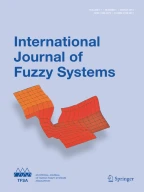Abstract
A new optimal robust control is proposed for mechanical systems with fuzzy uncertainty. Fuzzy set theory is used to describe the uncertainty in the mechanical system. The desirable system performance is deterministic (assuring the bottom line) and also fuzzy (enhancing the cost consideration). The proposed control is deterministic and is not the usual if–then rules-based. The resulting controlled system is uniformly bounded and uniformly ultimately bounded proved via the Lyapunov minimax approach. A performance index (the combined cost, which includes average fuzzy system performance and control effort) is proposed based on the fuzzy information. The optimal design problem associated with the control can then be solved by minimizing the performance index. The unique closed-form optimal gain and the cost are explicitly shown. The resulting control design is systematic and is able to guarantee the deterministic performance as well as minimizing the cost. In the end, an example is chosen for demonstration.
Similar content being viewed by others
Explore related subjects
Discover the latest articles, news and stories from top researchers in related subjects.References
Bede, B., Rudas, I.J., Fodor, J.: Friction Model by using Fuzzy Differential Equations. Foundations of Fuzzy Logic and Soft Computing, pp. 338–353. Springer, Berlin (2007)
Bezdek, J.C.: Special issue on fuzziness vs. probability—the N-th round. IEEE Trans. Fuzzy Syst. 2, 1–42 (1994)
Bronshtein, I.N., Semendyayev, K.A.: Handbook of Mathematics. Van Nostrand Reinhold, New York (1985)
Chen, Y.H.: Performance analysis of controlled uncertain systems. Dyn. Control 6, 131–142 (1996)
Chen, Y.H.: Fuzzy dynamical system approach to the observer design of uncertain systems. J. Syst. Control Eng. 224, 509–520 (2010)
Chen, Y.H., Leitmann, G.: Robustness of uncertain systems in the absence of matching assumptions. Int. J. Control 45, 1527–1542 (1987)
Corless, M.: Control of uncertain nonlinear systems. J. Dyn. Syst. Meas. Contr. 115, 362–372 (1993)
Hale, J.K.: Ordinary Differential Equations. Wiley, New York (1969)
Hanss, M.: Applied Fuzzy Arithmetic: An Introduction with Engineering Applications. Springer, Berlin (2005)
Huang, J., Chen, Y.H., Cheng, A.: Robust control for fuzzy dynamical systems: uniform ultimate boundedness and optimality. IEEE Trans. Fuzzy Syst. 20(6), 1022–1031 (2012)
Kalman, R.E.: A new approach to linear filtering and prediction problems. Trans. ASME, J. Basic Eng. 82D, 35 (1960)
Kalman, R.E.: Contributions to the theory of optimal control. Boletin de la Sociedad Mastematica Mexicana 5, 102–119 (1960)
Kalman, R.E.: Randomness reexamined. Model. Identif. Control 15, 141–151 (1994)
Klir, G.J., Yuan, B.: Fuzzy Sets and Fuzzy Logic: Theory and Applications. Pretice-Hall, Englewood Cliffs (1995)
Lee, T.S., Chen, Y.H., Chuang, J.: Robust control design of fuzzy dynamical systems. Appl. Math. Comput. 164(2), 555–572 (2005)
Leitmann, G.: on one approach to the control of uncertain systems. J. Dyn. Syst. Meas. Control 115, 373–380 (1993)
Li, X.P., Chang, B.C., Banda, S.S.: Robust control system design using H∞ optimization theory. J. Guid. Control Dyn. 2, 1975–1980 (1992)
McKerrow, P.J.: Introduction to Robotics. Addison-Wesley, Sydney (1991)
Schoenwald, D.A., Ozgunner, I.: Robust stabilization of nonlinear systems with parametric uncertainty. IEEE Trans. Autom. Control 39, 1751–1755 (1994)
Shen, T., Tamura, K.: Robust H∞ control of uncertain nonlinear system via state feedback. IEEE Trans. Autom. Control 40, 766–768 (1995)
Slotine, J.E., Li, W.: Applied Nonlinear Control. Prentice Hall, Englewood Cliffs (1991)
Soong, T.T.: Active Structural Control: Theory and Practice. Longman Scientific and Technical, Essex, England (1990)
Stengel, R.F.: Optimal Control and Estimation. Dover Publications, Mineola (1994)
Utkin, V.: Sliding mode control in mechanical systems. In: 20th International Conference on Industrial Electronics, Control and Instrumentation, vol. 3, pp. 1429–1431 (1994)
Xu, J., Chen, Y.H., Guo, H.: Fractional robust control design for fuzzy dynamical systems: an optimal approach. J. Intell. Fuzzy Syst. (2014). doi:10.3233/IFS-141316
Zadeh, L.A.: Fuzzy sets. Inf. Control 8, 338–353 (1965)
Acknowledgments
The authors would like to express sincere thanks to National Natural Science Foundation of China No.51275147, who have supported this research work.
Author information
Authors and Affiliations
Corresponding author
Appendix: fuzzy mathematics
Appendix: fuzzy mathematics
We briefly review some preliminaries regarding fuzzy numbers and their operations [14]:
1.1 Fuzzy number
Let G be a fuzzy set in R, the real number. G is called a fuzzy number if (i) G is normal, (ii) G is convex, (iii) the support of G is bounded, and (iv) all α-cuts are closed intervals in R.
Throughout, we shall always assume the universe of discourse of a fuzzy set number to be its 0-cut.
1.2 Fuzzy arithmetic
Let G and H be two fuzzy numbers and \( G_{\alpha } = [g_{\alpha }^{ - } ,g_{\alpha }^{ + } ] \), \( H_{\alpha } = [h_{\alpha }^{ - } ,h_{\alpha }^{ + } ] \) be their α-cuts, \( \alpha \in [0,1] \). The addition, subtraction, multiplication, and division of G and H are given by, respectively,
1.3 Decomposition theorem
Define a fuzzy set \( \tilde{V}_{\alpha } \) in U with the membership function \( \mu_{{\tilde{V}_{\alpha } }} = I_{{\tilde{V}_{\alpha } }} (x), \) where \( I_{{\tilde{V}_{\alpha } }} (x) = 1 \) if \( x \in \tilde{V}_{\alpha } \) and \( I_{{\tilde{V}_{\alpha } }} (x) = 0 \) if \( x \in U - \tilde{V}_{\alpha } \). Then the fuzzy set V is obtained as
where \( \cup \) is the union of the fuzzy sets (that is, sup over \( \alpha { \in }[0,1] \)).
Based on these, after the operation of two fuzzy numbers via their α-cuts, one may apply the decomposition theorem to build the membership function of the resulting fuzzy number.
Rights and permissions
About this article
Cite this article
Zhang, K., Han, J., Xia, L. et al. Theory and Application of a Novel Optimal Robust Control: A Fuzzy Approach. Int. J. Fuzzy Syst. 17, 181–192 (2015). https://doi.org/10.1007/s40815-015-0026-3
Received:
Revised:
Accepted:
Published:
Issue Date:
DOI: https://doi.org/10.1007/s40815-015-0026-3
